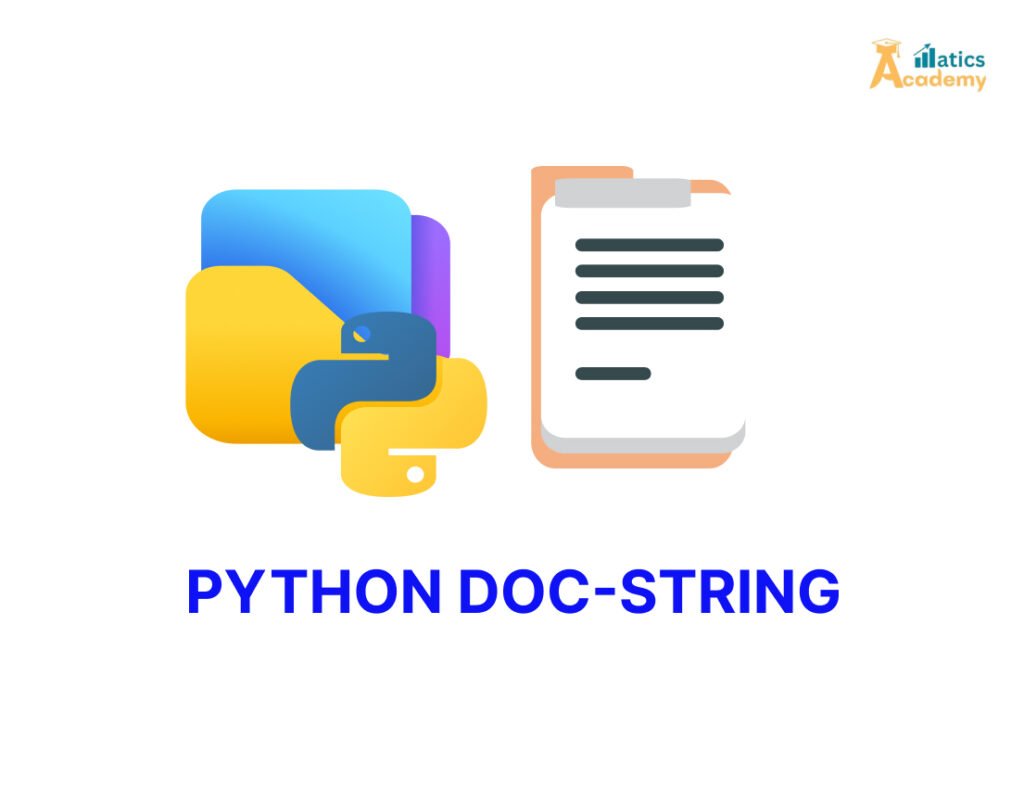Python, known for its simplicity and readability, provides a built-in feature called doc-strings to document code efficiently. Whether you are a beginner or an experienced developer, mastering Doc-strings is essential for writing maintainable and well-documented Python programs. This article will explore what Doc-strings are, how to use them, and best practices for writing effective Doc-strings.

What are Doc-Strings in python?
A Doc-String in python (short for documentation string) is a string literal used to describe a module, class, function, or method in Python. It serves as an inline documentation mechanism, allowing developers to explain the purpose and usage of their code directly within the code base.
Doc-strings are enclosed in triple quotes (''' or """) and are placed immediately after the definition of the object they document.
Key Features of Doc-Strings in python:
- They are accessible at runtime via the
__doc__attribute. - They improve code readability and maintainability.
- They are a standard practice for documenting Python code.
Why Use Doc-strings?
- Code Clarity: Makes your code easier to understand for others and for yourself when revisiting the code.
- Documentation Standards: Adhering to Python Enhancement Proposal (PEP) 257, doc-strings provide a standard way to document Python code.
- IDE Support: Modern IDE and tools can display doc-strings as tool-tips or in documentation panels.
- Ease of Maintenance: Well-documented code is easier to maintain and debug.
Types of Doc-Strings in python
- Module-Level Doc-strings
Describe the purpose of a Python module and provide an overview of its functionality. - Class Doc-strings
Describe the purpose of a class and its methods. - Function/Method Doc-strings
Explain the purpose, parameters, and return values of a function or method.
"""This module provides utilities for string manipulation."""
class Calculator:
"""A simple calculator class."""
def add(a, b):
"""Return the sum of two numbers.
Args:
a (int): The first number.
b (int): The second number.
Returns:
int: The sum of a and b.
"""
return a + b
How to Write Effective Doc-Strings
Follow these best practices for writing clear and concise doc-strings:
1. Keep It Brief and Descriptive
Write a one-line summary for simple functions or methods. For more complex code, add a detailed description after the summary.
"""Calculate the factorial of a number."""
2. Use Proper Formatting
Use triple quotes and start with a capital letter. Include a period at the end of the Doc-Strings.
"""This is a properly formatted docstring."""
3. Explain Parameters and Return Values
Use the Args, Returns, and Raises sections for functions and methods to document inputs, outputs, and exceptions.
def divide(a, b):
"""Divide two numbers.
Args:
a (float): The numerator.
b (float): The denominator.
Returns:
float: The result of the division.
Raises:
ZeroDivisionError: If the denominator is zero.
"""
if b == 0:
raise ZeroDivisionError("Cannot divide by zero.")
return a / b
4. Adhere to PEP 257
Follow the guidelines outlined in PEP- 257, which standardizes the structure and format of Doc-Strings in python.
Accessing Doc-Strings in python
Once defined, doc-strings can be accessed using the __doc__ attribute of an object. For example:
def greet():
"""Return a greeting message."""
return "Hello, World!"
# Accessing the docstring
print(greet.__doc__)
OUTPUT:
Return a greeting message.
Examples of Doc-Strings in python
1. Module Doc-string Example
"""This module provides mathematical operations."""
2.Class Doc-String Example
class Person:
"""A class representing a person."""
def __init__(self, name, age):
"""Initialize a new person instance."""
self.name = name
self.age = age
3.Function Doc-String Example
def square(number):
"""Return the square of a number."""
return number * number
Tools for Generating Documentation from Doc-Strings in python
Python provides tools to automatically generate documentation from Doc-strings, such as:
- Sphinx: Converts doc-strings into HTML, PDF, or other formats.
- pydoc: Generates text-based documentation directly in the terminal or browser.
To generate HTML documentation using pydoc, run:
pydoc -w your_module_name
Common Mistakes to Avoid
- Writing overly verbose or vague Doc-strings.
- Forgetting to update Doc-strings after modifying the code.
- Using inconsistent formatting or structure.
- Neglecting to document important parameters and return values.
Conclusion
Doc-strings in python are an integral part of writing clean, maintainable Python code. By documenting your code effectively, you enhance its readability and make it easier for others (and yourself) to use and maintain. Adopt the best practices outlined in this guide and make your Python projects stand out with well-crafted documentation.
INTERVIEW QUESTIONS
1.What is a Doc-String in python, and why is it important?
Company: Google
- Answer: A doc-string in Python is a special type of comment enclosed within triple quotes (
""" """or''' ''') used to document a specific segment of code, such as a function, class, or module. It provides a convenient way to describe the purpose and usage of the code for developers and users, improving readability and maintainability.
2.How do you write a Doc-String in python function? Provide an example.
Company: Amazon
- Answer: A Doc-string for a function is written immediately after the function definition. For example:
def add(a, b):
"""
Add two numbers and return the result.
Parameters:
a (int or float): The first number.
b (int or float): The second number.
Returns:
int or float: The sum of the two numbers.
"""
return a + b
3.How can you access a function’s Doc-String in python?
Company: Google
- Answer: You can access a function’s doc-string using the
__doc__attribute. - For example:
def greet():
"""This function prints a greeting message."""
print("Hello, World!")
print(greet.__doc__)
4.What is the difference between a comment and a Doc-String in python?
Company: TCS
- Answer:
- A comment is a single line or block of code ignored by the interpreter, starting with a
#symbol, meant for internal notes or explanations. - A doc-string is a string used to describe the functionality of a code segment and is accessible programmatically through the
__doc__attribute.
- A comment is a single line or block of code ignored by the interpreter, starting with a
5.What conventions are commonly followed when writing Doc-Strings in python?
Company: TCS
- Answer: Common conventions include:
- Using triple quotes for the doc-string (
"""or'''). - Including a brief description of the functionality.
- Adding sections for parameters, return values, exceptions, and usage examples if applicable.
- Following PEP 257 guidelines for Doc-string formatting.
- Using triple quotes for the doc-string (
QUIZZES
Doc-string in python Quiz
Question
Your answer:
Correct answer:
Your Answers
